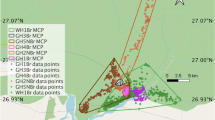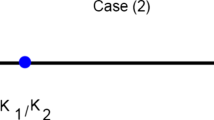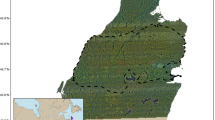Abstract
Hilltopping butterflies direct their movement in response to topography, facilitating mating encounters via accumulation at summits. In this paper, we take hilltopping as a case study to explore the impact of complex orienteering cues on population dynamics. The modelling employs a standard multiscale framework, in which an individual’s movement path is described as a stochastic ‘velocity-jump’ process and scaling applied to generate a macroscopic model capable of simulating large populations in landscapes. In this manner, the terms and parameters of the macroscopic model directly relate to statistical inputs of the individual-level model (mean speeds, turning rates and turning distributions). Applied to hilltopping in butterflies, we demonstrate how hilltopping acts to aggregate populations at summits, optimising mating for low-density species. However, for abundant populations, hilltopping is not only less effective but also possibly disadvantageous, with hilltopping males recording a lower mating rate than their non-hilltopping competitors.









Similar content being viewed by others
References
Alcock J (1987) Leks hilltopping in insects. J Nat Hist 21:319–328
Baughman JF, Murphy DD (1988) What constitutes a hill to a hilltopping butterfly?Amer Mid Nat 120:441–443
Baughman JF, Murphy DD, Ehrlich PR (1988) Population structure of a hilltopping butterfly. Oecologia 75:593–600
Berens P (2009) CircStat: a Matlab toolbox for circular statistics. J Stat Soft 31:1–21
Bowers MD, Brown IL, Wheye D (1985) Bird predation as a selective agent in a butterfly population. Evolution 39:93–103
Cant ET, Smith AD, Reynolds DR, Osborne JL, Cant ET, Smith AD, Reynolds DR, Osborne JL (2005) Tracking butterfly flight paths across the landscape with harmonic radar. Proc Roy Soc B Biol Sci 272:785–790
Cantrell RS, Cosner C (2004) Spatial ecology via reaction–diffusion equations. Wiley
Codling EA, Plank MJ, Benhamou S (2008) Random walk models in biology. J Roy Soc Interface 5:813–834
Codling EA, Bearon RN, Thorn GJ (2010) Diffusion about the mean drift location in a biased random walk. Ecology 91:3106–3113
Courtney SP, Anderson K (1986) Behaviour around encounter sites. Ecol Sociobiol 19:241–248
Dover J, Settele J (2009) The influences of landscape structure on butterfly distribution and movement: a review. J Insect Cons 13:3–27
Ehrlich PR, Hanski I (2004) On the wings of checkerspots: a model system for population biology. Oxford University Press, USA
Ehrlich PR, Wheye D (1986) Nonadaptive hilltopping behavior in male checkerspot butterflies (Euphydryas editha). Amer Nat 127:477–483
Ehrlich PR, Launer AE, Murphy DD (1984) Can sex ratio be defined or determined? The case of a population of checkerspot butterflies. Amer Nat 124:527–539
Erban R, Haskovec J (2012) From individual to collective behaviour of coupled velocity jump processes: a locust example. Kin Rel Mod 5:817–842
Franz B, Xue C, Painter KJ, Erban R (2013) Travelling waves in hybrid chemotaxis models. Submitted
Hanski I (1999) Metapopulation ecology. Oxford University Press, Oxford
Hellmann JJ, Weiss SB, Mclaughlin JF, Boggs CL, Ehrlich PR, Launer AE, Murphy DD (2003) Do hypotheses from short-term studies hold in the long-term? An empirical test. Ecol Entomol 28:74–84
Hillen T (2003) Transport equations with resting phases. Eur J Appl Math 14:613–636
Hillen T (2006) M5 mesoscopic macroscopic models for mesenchymal motion. J Math Biol 53:585–616
Hillen T, Painter KJ (2013) Transport and anisotropic diffusion models for movement in oriented habitats. In: Dispersal, individual movement and spatial ecology: a mathematical perspective. Springer, Heidelberg, pp 177–222
Hillen T, Painter KJ, Winkler M (2013) Anisotropic diffusion in oriented environments can lead to singularity formation. Eur J Appl Math 24:371–413
Iwasa Y, Odendaal FJ, Murphy DD, Ehrlich PR, Launer AE (1983) Emergence patterns in male butterflies: a hypothesis and a test. Theor Pop Biol 23:363–379
Jiggins FM, Hurst GDD, Majerus MEN (2000) Sex-ratio-distorting Wolbachia causes sex-role reversal in its butterfly host. Proc Roy Soc Lond B Biol Sci 267:69–73
Kareiva PM, Shigesada N (1983) Analyzing insect movement as a correlated random walk. Oecologia 56:234–238
Kingsolver JG (1983) Thermoregulation and flight in Colias butterflies: elevational patterns and mechanistic limitations. Ecology 64:534–545
Mardia KV, Jupp PE (2000) Directional statistics. Wiley, New York
McKenzie HW, Merrill EH, Spiteri RJ, Lewis MA (2012) How linear features alter predator movement and the functional response. Roy Soc Interface Focus 2:205–216
Moorcroft P, Lewis MA (2006) Mechanistic home range analysis. Princeton University Press, USA
Mosayebi P, Cobzas D, Jagersand M, Murtha A (2010) Stability effects of finite difference methods on a mathematical tumor growth model. In: Computer vision and pattern recognition workshops (CVPRW), 2010 IEEE computer society conference on. IEEE, pp 125–132
Okubo A, Levin SA (2001) Diffusion and ecological problems: modern perspectives. Springer Verlag
Othmer HG, Xue C (2013) The mathematical analysis of biological aggregation and dispersal Dispersal, individual movement and spatial ecology: a mathematical perspective. Springer, Heidelberg
Othmer HG, Dunbar SR, Alt W (1988) Models of dispersal in biological systems. J Math Biol 26:263–298
Painter KJ (2009) Modelling cell migration strategies in the extracellular matrix. J Math Biol 58:511–543
Painter KJ, Hillen T (2013) Mathematical modelling of glioma growth: the use of diffusion tensor imaging (DTI) data to predict the anisotropic pathways of cancer invasion. J Theor Biol 323:25–39
Patlak CS (1953) Random walk with persistence external bias. Bull Math Biol 15:311–338
Pe’er G (2003) Spatial and behavioral determinants of butterfly movement patterns in topographically complex landscapes. PhD thesis, Ben-Gurion University of the Negev
Pe’er G, Saltz D, Thulke HH, Motro U (2004) Response to topography in a hilltopping butterfly and implications for modelling nonrandom dispersal. Anim Behav 68:825–839
Pe’er G, Saltz D, Frank K (2005) Virtual corridors for conservation management. Conserv Biol 19:1997–2003
Peer G, Heinz SK, Frank K (2006) Connectivity in heterogeneous landscapes: analyzing the effect of topography. Land Ecol 21:47–61
Rutowski RL (1991) The evolution of male mate-locating behavior in butterflies. Amer Nat 138:1121–1139
Scott JA (1968) Hilltopping as a mating mechanism to aid the survival of low density species. J Res Lepid 7:191–204
Scott JA (1973a) Lifespan of butterflies. J Res Lepid 12:225–230
Scott JA (1973b) Mating of butterflies. J Res Lepid 11:99–127
Shields O (1967) Hilltopping. J Res Lepid 6:69–178
Skellam JG (1951) Random dispersal in theoretical populations. Biometrika 38:196–218
Tomkiewicz SM, Fuller MR, Kie JG, Bates KK (2010) Global positioning system and associated technologies in animal behaviour and ecological research. Phil Trans Roy Soc B Biol Sci 365:2163–2176
Turchin P (1998) Quantitative analysis of movement: measuring and modeling population redistribution in animals and plants. Sinauer Associates, Sunderland
Turchin P, Odendaal FJ, Rausher MD (1991) Quantifying insect movement in the field. Environ Entomol 20:955–963
Weickert J (1998) Anisotropic diffusion in image processing. Teubner, Stuttgart
Weiner R, Schmitt BA, Podhaisky H (1997) ROWMAP—a row-code with Krylov techniques for large stiff ODEs. Appl Numer Math 25:303–319
Wickman PO (1988) Dynamics of mate-searching behaviour in a hilltopping butterfly, lasiommata megera (l.): the effects of weather and male density. Zool J Linn Soc 93:357–377
Acknowledgments
The author wishes to thank Thomas Hillen and Jonathan Sherratt for their comments and suggestions on earlier drafts of this manuscript. The author also acknowledges the support of the Leverhulme Trust for a Research Fellowship Grant.
Author information
Authors and Affiliations
Corresponding author
Appendix: Numerical methods
Appendix: Numerical methods
Stochastic individual-based model
Each individual starts at t = 0 with position and velocity according to the given initial distributions. A movement path is generated through direct simulation of the stochastic velocity-jump process in Matlab. If t i represents a time at which a turn is made, x i is the location of the individual at this time and v i − 1 is its previous velocity:
-
1.
The new velocity v i is chosen according to the proposed velocity distribution q;
-
2.
The new runtime τ i is selected from a Poisson distribution, with turning rate parameter λ ( = 1/τ, where τ is the mean runtime).
-
3.
The individual is moved to position x i + 1 = x i + τ i v i , time is incremented to t i + 1 = t i + τ i and the process is repeated.
For velocity distributions based on the von Mises distribution, we employ code (circ _vmrnd.m) from the circular statistics toolbox (Berens 2009). Selecting an orientation according to this distribution requires a concentration parameter (κ) and dominant angle (ϕ), drawn from the local gradient of an underlying orienteering cue E(x). For landscapes such as Arthur’s seat, where terrain data is only available at discrete points, local gradients of E are approximated via a central difference scheme.
Mesoscopic velocity-jump model
Equation (3) is solved using a method of lines (MOL) approach: we discretise in position and velocity space to create a large system of ordinary differential equations (ODEs) to be solved with an appropriate time integration method. In two dimensions, with fixed speed s, positional coordinates (x, y) ∈ A = 0, L x × 0, L y are discretised onto a regular lattice \(x_{1} = \frac {\Delta _{x}}{2}, x_{2} = \frac {3 \Delta _{x}}{2} \hdots , x_{M} = L_{x} - \frac {\Delta _{x}}{2}\), \(y_{1} = \frac {\Delta _{y}}{2}, y_{2} = \frac {3 \Delta _{y}}{2} \hdots , y_{N} = L_{y} - \frac {\Delta _{y}}{2}\) for Δ x = L x / M, Δ y = L y / N, while velocity v = s(cosθ, sinθ) is discretised according to its angular coordinate θ ∈ ( − π, π such that θ 1 = − π + Δ θ , θ 2 = − π + 2Δ θ , … , θ P = π, where Δ θ = 2π / P,
Spatial terms consist of the advective term representing movement: this is discretised in conservative form via a third-order upwinding scheme, augmented with a flux-limiting scheme to ensure positivity of solutions. The righthand side terms of (3) are treated as kinetic-type terms. Integration of the ODEs has been performed with both explicit and implicit schemes: the former a forward Euler method with sufficiently small time step, the latter with the rowmap stiff systems integrator (Weiner et al. 1997). Tests using the two time iteration methods yield equivalent results and simulations have been performed across a range of discretisation steps. Default discretisations for the simulations employ N = M = 200 and P = 100.
Macroscopic model
We also employ a MOL scheme to solve the macroscopic Eq. (5). The spatial region A is discretised using the same regular lattice as above for the transport model. In 2D, assuming the drift vector and diffusion tensor are of the form
we can expand the spatial terms of (5) as follows
The above reveals a combination of diffusive (first line) and advective (second line)-type terms, with the diffusive terms in the first line identical to those generated for standard anisotropic diffusion.
The choice of finite difference discretisation for diffusive terms is crucial: naive discretisations can lead to numerical instability for large and negative γ, see Mosayebi et al. (2010). The possibility of numerical instability can be reduced using the method in Weickert (1998): finite difference derivatives are calculated not only along the ‘standard’ axes of the lattice, but combined with those in an appropriately chosen new direction. Advective terms are discretised in conservative form, employing a first-order upwinding scheme. Time integration involves a forward Euler method with a suitably small time step Δt. To verify the numerical method, simulations have been performed for varying time-step and mesh-discretisations. The validity of the various numerical methods is further substantiated by convergence of the models within relevant regimes.
Rights and permissions
About this article
Cite this article
Painter, K.J. Multiscale models for movement in oriented environments and their application to hilltopping in butterflies. Theor Ecol 7, 53–75 (2014). https://doi.org/10.1007/s12080-013-0198-0
Received:
Accepted:
Published:
Issue Date:
DOI: https://doi.org/10.1007/s12080-013-0198-0




